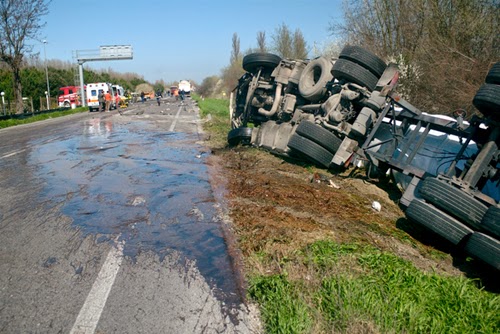THE LEADING CAUSES OF SEMI TRUCK ACCIDENTS AND THE NUMBER
ONE SAFE DRIVING RULE
Here are some of the leading causes of accidents:
·
Distracted Drivers,
·
Rear End Truck Collisions,
·
Left Turn Violations,
·
Running Red Lights and Stop Signs,
·
Drunk Drivers,
·
Big Truck Roll-Overs and
·
Unsafe Lane Changes.
Most all of these accidents have one thing in common: One or
more drivers violated One Safe Driving Rule;
1.
"Failure to Look Ahead as Far as You Can
See When Driving" or
2.
"Failure to pay attention to the road"
especially when talking on the phone or texting, etc.
Don't become a statistic by following their example. Use this simple safe driving tip that
professional drivers know and trust. This is THE NUMBER ONE SAFE DRIVING RULE
FOR TRUCKERS. When this rule is
violated, disastrous consequences may result. You'll see many of these unfortunate drivers
as you look the accident reports.
Truckers First Safe
Driving Rule
"WHEN DRIVING, ALWAYS LOOK AHEAD AS FAR AS YOU CAN
SEE".
Following this ONE simple rule will keep you out of trouble
most of the time and you will experience less stress in your driving life
because you will have time to respond to most emergencies in a professional,
relaxed manner with plenty of time to make course corrections or adjust your
speed.
Look down your path of future travel far into the night or day.
Let nothing important escape your attention.
Look for stopped or slow moving traffic in the distance.
Watch for road hazards such as stalled or wrecked vehicles in
the travel lanes or on the shoulder. Watch
for traffic officers giving someone a ticket, aiming a laser gun in your direction
or attending to a stalled vehicle or chasing someone down the highway.
Fatigue among truck drivers a growing threat on
U.S. highways
NEW YORK (PIX11) – The New York
State Department of Motor Vehicles say that in 2013 alone, there were 94
fatalities as a result of tractor trailer crashes. Those numbers are no doubt
shocking.
However, when you expand to the entire nation, the number of
fatal crashes rises to nearly 4,000.
In the past three weeks, we have reported two different fatal
crashes during the PIX11 Morning News, which snarled traffic during the morning
rush.
Back in June, a Walmart truck barreled through a construction
zone and collided with a party van. The impact critically injured
comedian Tracy Morgan and killed his friend James McNair.
The driver of that truck had not slept in 24 hours and is now
facing charges.
In 2012, there were more than 300,000 crashes involved trucks
nationwide. Locally, in New York state, there were 12,000 crashes.
In most cases, the driver of the big rig walks away unharmed.
Morgan’s crash and a wreck involving Marilu Rodriguez highlight a growing issue
of driver fatigue.
“I thought my son was dead, I didn’t want to look in the
backseat,” Rodriguez said, describing the moments after after she was hit by a
tractor trailer in 2006 along the New Jersey Turnpike.
“The worst part was knowing I was going to be hit and there was
just nothing I could do about it.”
Attorney Alan Markman sees the issue of driver fatigue as a
huge problem on the roads.
“If you want to put a percentage on it, I would say 90 percent
of truck driver accidents relate to fatigued, simply too many hours on the
road,” Markman said.
That was partially to blame in Rodriguez’s case.
“I can hear the metal , his tires screeching,” she recalled. “
I can hear the windows popping. It is something you just never forget.
“I was in such a daze. I didn’t know what was going on. I
stepped out of the car and when I looked up, I was walking into traffic.”
In the backseat was Rodriguez’s 12-year-old son, who she thought
had died.
“ I really thought my son had not made it. But then I heard his
squeaky little voice,” Marilu said.
Marilu’s son miraculously walked away unharmed, however, she
did not. She had to have a metal cage surgically implanted in her back and is
now on pain medication for the rest of her life.
The driver of the crash settled the case before it went to
court. There was a big reason for that happening according to
her attorney.
“Not only were the records on the truck inaccurate,” Makman
said. “But the vehicle itself should not have been on the road in the first
place.”


